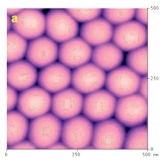In this work, it has been shown that, through a highly controlled process, the chemical etching of the anodic aluminum oxide membrane barrier layer can be performed in such a way as to achieve nanometer-scale control of the pore opening. As the barrier layer is etched away, subtle differences revealed through AFM phase imaging in the alumina composition in the barrier layer give rise to a unique pattern of hexagonal walls surrounding each of the barrier layer domes. These nanostructures observed in both topography and phase images can be understood as differences in the oxalate anion contaminated alumina versus pure alumina. This information bears significant implication for catalysis, template synthesis, and chemical sensing applications. From the pore opening etching studies, the etching rate of the barrier layer (1.3 nm/min) is higher than that of the inner cell wall (0.93 nm/min), both of which are higher than the etching rate of pure alumina layer (0.5-0.17 nm/min). The established etching rates together with the etching temperature allow one to control the pore diameter systematically from 10 to 95 nm.
Porous anodic aluminum oxide (AAO) membranes have attracted significant interest during recent years due to the fact that they are readily synthesized through a simple procedure and extremely useful in nanoscience studies. Pore diameter (10-300 nm) and pore-pore distance (25-500 nm) can be controlled over a narrow distribution range through proper selection of the type and concentration of electrolyte, applied anodization potential, and temperature.1-4 Highly ordered, straight nanopores in hexagonally close-packed arrays with domain sizes of approximately 2.5 × 2.5 µm2 and aspect ratios as high as 1000 can be readily achieved. The pore-pore distance and barrier oxide layer thickness are mainly determined by the applied anodization potential, while the electrolyte pH determines the dissolution rate of aluminum oxide, which directly affects the resulting pore diameter.
A hemispherical shell with homogeneous thickness known as the barrier layer develops at the bottom of every nanopore during the anodization process. To date, this barrier layer has not attracted much attention in the literature, even though many applications require its removal to create through-hole membranes. Examples for such applications include energy-efficient gas separation and pattern-transfer masks for e-beam evaporation,19 reactive ion etching,20 or molecular-beam epitaxial growth.21 Through a carefully controlled barrier layer etching process, one can systematically prepare a tunable pore opening. Three methods had been used to open the barrier oxide layer: wet chemical etching,1-3 ion milling,22 and plasma etching.20 Of these, the wet etching has been regarded as difficult to control and only ion milling has received more detailed analysis in the literature.
While there seems to be a number of researchers utilizing chemical etching for opening the barrier layer, very little detailed study has been made in the past to reveal the barrier layer opening process. As such, there is a lack of knowledge concerning the dynamics of this process. The most common remark upon this process that can be found in the literature is “...the barrier layer is removed in 5% H3PO4 at 30 °C for 60 min.”1 Our experimental results show that if the chemical etching is done with proper control, 10-95 nm openings in the barrier layer can be obtained systematically for AAO membranes made in oxalic acid. In addition, very interesting double hexagon nanostructures were observed for the first time through AFM imaging before complete removal of the barrier layer. These nanostructures reveal the impurity distribution in the membranes that bear significant implication for catalysis and sensing applications.
The first anodization step was carried out in a 0.3 M oxalic acid solution at 3 °C for 24 h. The 70 µm thick porous alumina layer was then stripped away from the Al substrate by etching the sample in a solution containing 6 wt % phosphoric acid and 1.8 wt % chromic acid at 60 °C for 12 h. This step not only removes the disordered AAO membrane but also leaves a highly ordered dimple array on the aluminum surface. Each dimple initiates new pore formation during the second anodization step, which was carried out under the same conditions as the first step. A freestanding AAO membrane with highly ordered arrays of nanopores was then obtained by selectively etching away the unreacted Al in a saturated HgCl2 solution.

Fig1
As can be seen from the images, the pores become more circular as etching progresses. This is similar to other techniques, like ion milling, where the pore shape is fairly circular at larger pore diameters (ca. 45 nm) but some distortion is still observed.22 While these images may represent the true shape of the hole, especially at the smaller diameters, there is also the possibility that there is a convolution between the AFM tip and hole that is distorting the image. We suspect that this is partially the case as there were some changes in the image depending on the scan direction, which is a clear indication that tip shape is affecting the image. Even if this is the case though, these results suggest that applications that require a very uniform shape should utilize membranes that have been etched for longer periods of time to ensure a more uniform pore shape.
上一篇: 过程化学品和去离子水以及硅表面